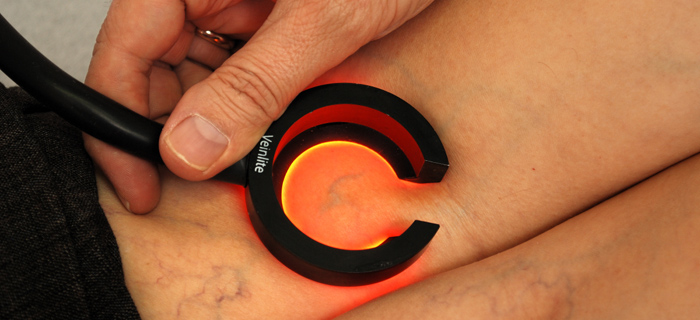
What is sclerotherapy?
Sclerotherapy is the modern minimaly invasive method of treatment of varicose veins and capillaries (telangiectasia), it consists of injecting a special solution called sclerosing agent or sclerosant into the veins of the patient. Sclerotherapy is a method of treatment that leaves no scars and the recovery period is shorter.
What types of sclerotherapy are there?
In sclerotherapy a liquid or foam can be used and Dr. Ivan Kyuchukov uses both methods of treatment. In general, a liquid solution is used in smaller vessels and foam for larger. The foam is set up immediately before injection by mixing different amounts of liquid and gas. Sclerotherapy may be carried out with Doppler (ultrasound) control or with the aid of the apparatus Veinlite, depending on the size and depth of the treated vessel. Your doctor evaluates individually what method to use and if there would be any need of a guiding apparatus for your treatement, depending on the diagnosis.
What diseases can be treated with sclerotherapy?
Sclerotherapy is suitable for the treatment of varicose veins, telangiectasia, reticular veins and CVI
Is sclerotherapy effective for all patients?
In 90% of the cases where sclerotherapy is carried out varicose veins disappear completely. However, there is no guarantee that sclerotherapy will be effective in all cases. Approximately 10% of the patients who undergo sclerotherapy have unsatisfactory results (this means that the veins are not completely removed after 6 courses). In very rare cases, the patient's condition may worsen after sclerotherapy.
In these cases, treatment with sclerotherapy is suspended and a more appropriate method is used. There are other mini-invasive methods for treatment of varicose veins suitable for patients who do not respond well to sclerotherapy.
How many procedures are required?
The number of courses required to eliminate or improve the condition of varicose veins vary between patients. Usually it depends on the extent of the disease. From one to six sessions may be conducted, as an average of 3-4 suffice. The optimal period between treatments is 4-6 weeks.
What are the most common side effects?
There are no severe life-threatening complications when sclerotherapy is properly performed. The blue spots (hematoma) at the injection site,the swelling, redness, feeling of tension and itching along the vein are normal complaints and disappear completely for a few days.
Immediately after the intervention painful and bold seals can be felt along the treated vein, which also disappear by themselves after a short period of time.
Approximately 30% of patients who undergo sclerotherapy observe coloration of the skin over the vein (thin brown stripes). In almost all cases the veins darken after the procedure. This pigmentation gradually fades but rarely it lasts from 4 to 12 months.
Are there any side effects?
Allergic reactions (to sclerosing agents, disinfectants, latex gloves or dressings) might occur with transient swelling, itching, skin reactions, dizziness, headache, metallic taste in the mouth, vomiting and other phenomena. They resolve spontaneously or with appropriate treatment.
If sclerosing agent is injected outside the vein pain and / or inflammation of the subcutaneous tissue may occur. Extremely rare this can lead to the formation of a wound that is treated for several days.
Exposure of the skin nerves within the scope of the sclerosing agent can cause transient sensation of numbness or hypersensitivity of the skin. Other side effects include pain during the injection of the solution, neovascularisation (temporary development of small "fragile" capillaries), transient phlebitic reactions (temporary swelling of the vein can lead to swelling of the ankle), temporary spots (like hives) and very rarely difficult to heal infected wounds (for diabetics).
Thrombophlebitis is a rare complication in approximately 1 in 10 000 patients whose veins are larger than 3-4 mm.